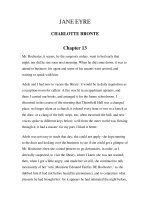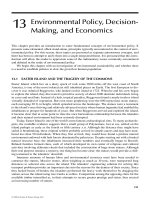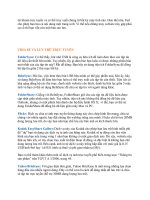EC&M’s Electrical Calculations Handbook - Chapter 13 doc
Bạn đang xem bản rút gọn của tài liệu. Xem và tải ngay bản đầy đủ của tài liệu tại đây (382.48 KB, 20 trang )
Circuits for
Special Loads
Designing Circuits for Various Electrical
Loads
The normal procedure used to determine circuit sizes and
characteristics for typical loads is to determine the wiring
method and conductor and insulation types to be used from
the installation-site environmental data, solve for the cur-
rent that will be drawn by the load, select the conductor
size, and then determine the raceway size. After all this is
completed, a calculation of the voltage drop in the system is
normally done to determine that sufficient operating volt-
age is available at the terminals of the load for it to operate
satisfactorily. A solution using this methodology is shown in
Fig. 13-1. When the load can operate for 3 hours or longer,
it is considered to be a continuous-duty load, and the circuit
must be designed for continuous operation. Figure 13-2 is
the solution method used for designing the electrical circuit
to a continuous load.
There are many types of electrical loads that exhibit special
operational characteristics, such as large inrush currents on
initial energization. The electrical system must be designed to
Chapter
13
335
v
Copyright 2001 by The McGraw-Hill Companies, Inc. Click here for Terms of Use.
Figure 13-1
Solve for the conductor size and overcurrent
device rating for a
general load.
336
Figure 13-2
Solve for the conductor size and overcurrent
device rating for a
general continuous load.
337
permit these unique loads to start and operate successfully
while still providing protection from abnormal current flow.
For example, when starting a motor, a large inrush current
flows until the motor can establish a “back emf” to limit line
current. The electrical system must permit this inrush cur-
rent to flow to start the motor, but it also must be able to inter-
rupt it if the motor does not accelerate to speed in normal
338 Chapter Thirteen
Switchboard and transfer switches require working clearance in
front, but not to the side.
time, lest the motor be damaged or destroyed by excessive I
2
R
heat. Then the same electrical system must continuously
monitor motor running current to also prevent long-time over-
load from damaging the motor. The following figures illustrate
calculations required by specific types of appliances in the
design of electric circuits to permit unique loads to start and
to continue to protect them during operation:
Figure 13-3: Air-conditioning equipment
Figure 13-4: Household appliances
Figure 13-5: Heat tracing with self-regulating cable (see
Note below)
Figure 13-6: Heat tracing with constant-wattage cable
Figure 13-7: Lighting fixtures
Figure 13-8: Electrical power receptacles with unidenti-
fied loads
Figure 13-9: Electrical power receptacle with specific load
Note: Some of these examples use actual field experience
rather than code requirements for sizing. For example, field
experience with self-regulating heat-tracing cable shows that
initial energization inrush current of up to 4.9 times full-load
rating current occurs for 3 to 5 minutes in dry locations and
indefinitely in wet locations. Therefore, the circuit breaker
and conductors must be sized to deliver this current, lest the
electrical power system fail or trip “off” to this most important
load. For this reason, the electrical engineer and designer
should make every effort to obtain the appliance manufactur-
er’s actual load characteristics for each electrical load.
Designing an Electrical System for a
Commercial Building
The electrical system for a commercial building must be large
enough to safely supply the facility electrical loads. While this
can be done based on physics, over the last century, the best
minds in the electrical industry have contributed information
Circuits for Special Loads 339
Figure 13-3
Solve for the conductor size, overcurrent device
rating, and dis-
connect rating for an HVAC load.
340
Figure 13-4
Solve for the conductor size and overcurrent
device rating for a
general household appliance.
341
Figure 13-5
Solve for the conductor size and overcurrent
device rating for a
self-regulated heat tracing cable.
342
Figure 13-6
Solve for the conductor size and overcurrent
device rating for a
constant-wattage heat tracing cable.
343
Figure 13-7
Solve for the conductor size and overcurrent
device rating for a
commercial lighting load.
344
Figure 13-8
Solve for the conductor size and overcurrent device
rating for
gen-
eral receptacle loads.
345
346
Figure 13-9
Solve for the conductor size and overcurrent device
rating for
spe-
cific receptacle loads.
to the National Electrical Code (NEC), which now sets the
standards for the characteristics of the required electrical
system. Accordingly, this book both points out the require-
ments using calculation methodology and provides NEC ref-
erence information where the engineer and designer can
obtain further information.
For every feeder and switchgear bus, panelboard bus, or
motor control center bus, a separate calculation must be
made; however, these calculations are all very similar, with
only the connected loads changing. The first of the calcula-
tions that must be made is for the service feeder and service
equipment.
The following six general groups of loads must be consid-
ered within commercial buildings:
1. Lighting
2. Receptacle loads
3. Special appliance loads
4. Motor loads other than heating, ventilation, and air-con-
ditioning (HVAC) loads
5. The greater of
a. HVAC compressor loads and hermetically sealed
motor loads, or
b. Heating loads
Lighting loads consist of
1. The greater of 125 percent (for continuous operation) of
the quantity of voltamperes per square foot shown in
NEC Table 220-3(a) or 125 percent of the actual lighting
fixture load, including low-voltage lighting (Article 411),
outdoor lighting, and 1200-voltampere (VA) sign circuit
[600-4(b)(3)].
2. 125 percent of show window lighting [220-12(a)].
3. Track lighting at 125 percent of 150 VA per lineal foot
[220-12(b)].
Receptacle loads consist of
1. 100 percent of the quantity of 1 VA/ft
2
shown in Table 220-
3(a) or 100 percent of 180 VA per receptacle [220-3(b)(9)].
Circuits for Special Loads 347
2. 100 percent of specific appliance loads that “plug into”
receptacles or 125 percent of specific appliance loads that
can operate continuously (for 3 hours or longer) that
“plug into” receptacles.
3. 100 percent of 180 VA per 5 ft of multioutlet assembly or
100 percent of 180 VA per 1 ft of multioutlet assembly,
when every receptacle will be used.
348 Chapter Thirteen
Control room of an industrial facility.
Induction motors driving pumps in industrial facility.
Special appliance loads consist of 100 percent of the
voltampere rating of each appliance that will not run con-
tinuously and 125 percent of each appliance that will run
continuously.
Motor loads other than HVAC loads, in accordance with
NEC Article 430, consist of 125 percent of the largest table
ampere size motor plus 100 percent of all other motors,
except that any motor that is noncoincidental with another
need not be considered. For example, if a building contains
two chilled water pumps, P-1A and P-1B, where P-1B serves
as a backup to P-1A, then only one of the two pumps can be
expected to be running. In this case, the load flow analysis
should include P-1A but not P-1B.
HVAC loads consist of heating and cooling loads.
Frequently, these heating and cooling loads are noncoinci-
dental, with heating loads only running when cooling is not
required, and vice versa. The feeder that serves both nonco-
incidental loads only needs to be sized for the larger of the
two. Note, however, that some loads, such as air-handling
loads, operate with either heating or cooling and must be
added to the load listing for either case.
Demand factors can be applied to receptacle loads (NEC
Table 220-13 lists specific factors), to commercial cooking units
(NEC Table 220-20 lists specific factors), to welders (630-11), to
cranes (610-14), and to motors that will not be running simul-
taneously (430-26). The demand factor for a group of motor
loads must be determined by the engineer or designer.
As an example, Fig. 13-10 shows a calculation of the mini-
mum service feeder ampacity required for a commercial
building that consists of 100,000 ft
2
of office space with one
50-horsepower (hp) air-handling unit, one 250-hp chiller with
a branch circuit selection current of 250 A at 480 V three-
phase, one 10-hp domestic water pump, and one 30-kilowatt
(kW) heating coil that provides reheat dehumidification.
Designing an Electrical System for an
Industrial Facility
Engineering and design work in an industrial facility is sim-
ilar to that in commercial buildings, except that the loads are
Circuits for Special Loads 349
Figure 13-10
Solve for service for a commercial building.
350
quite different in type and rating. The electrical load of the
buildings in a typical industrial plant is normally much
smaller than the large-process load, and the design reliabili-
ty considerations are different. In commercial buildings, the
emphasis is on personnel safety first and equipment func-
tionality second. In many industrial plants, the process
equipment is unmanned, and process interruptions can cause
Circuits for Special Loads 351
Motor control center.
Figure 13-11
Solve for service for an industrial plant.
352
millions of dollars in damage losses. Therefore, the continuity
of electrical power to the process equipment is frequently
treated with as much design care as the design for continuity
of electrical power to the life safety electrical system branch
of a hospital electrical system. These two changes, the size of
the loads and system redundancy requirements, are shown
clearly in the following example of sizing of an electrical sys-
tem in an industrial plant, as shown in Fig. 13-11. This sys-
tem consists of the following loads:
1. A 3000-ft
2
control building
2. A 2000-ft
2
switchgear building
3. A 10-kilovoltampere (kVA) redundant uninterruptible
power system (UPS) to energize the distributed control
system (DCS)
4. The following series of pumps and fans:
a. P-1101A and P-1101B, 10 horsepower (hp), 460 volts
(V)
b. P-1601A, P1601B, 50 hp, 460 V
c. Ten 30-hp finfan motors, 460 V
d. One 20-kW cathodic protection system
e. 50 kW of lighting in the process facility
5. One 10-ton air-conditioner package unit with a 50-hp motor
Circuits for Special Loads 353
Industrial plants commonly incorporate prefabricated switchgear
buildings.
6. One 6000-kW compressor motor that has an operating
power factor of 0.90 at 13.8 kV
The electrical power system to the industrial plant is
redundant from the electrical utility, serving the industrial
plant at 13.8 kV; therefore, each service is capable of oper-
ating the entire plant and is sized to support the load of the
entire plant.
354 Chapter Thirteen









